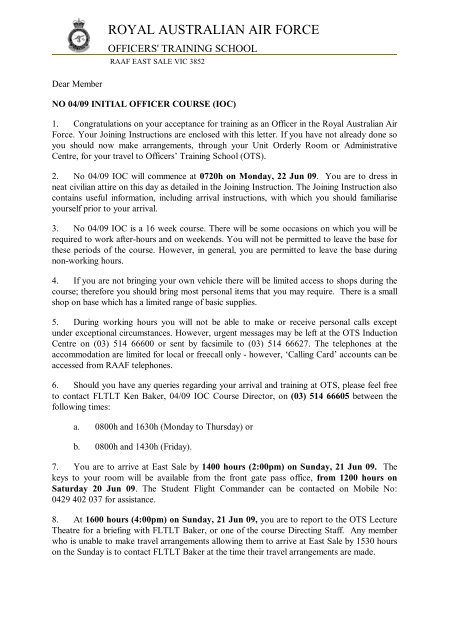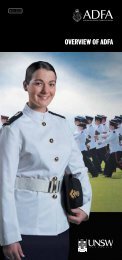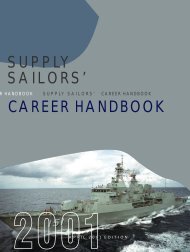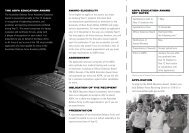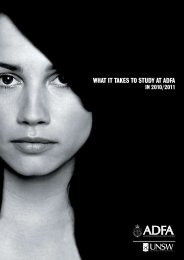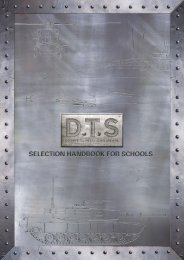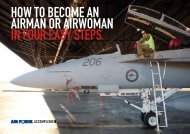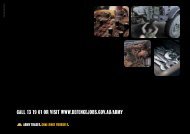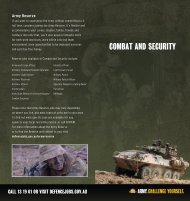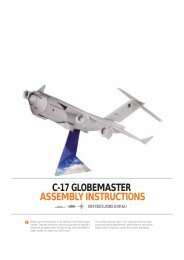OFFICERS' TRAINING SCHOOL - Australian Defence Force Recruiting
OFFICERS' TRAINING SCHOOL - Australian Defence Force Recruiting
OFFICERS' TRAINING SCHOOL - Australian Defence Force Recruiting
You also want an ePaper? Increase the reach of your titles
YUMPU automatically turns print PDFs into web optimized ePapers that Google loves.
ROYAL AUSTRALIAN AIR FORCE<strong>OFFICERS'</strong> <strong>TRAINING</strong> <strong>SCHOOL</strong>RAAF EAST SALE VIC 3852Dear MemberNO 04/09 INITIAL OFFICER COURSE (IOC)1. Congratulations on your acceptance for training as an Officer in the Royal <strong>Australian</strong> Air<strong>Force</strong>. Your Joining Instructions are enclosed with this letter. If you have not already done soyou should now make arrangements, through your Unit Orderly Room or AdministrativeCentre, for your travel to Officers’ Training School (OTS).2. No 04/09 IOC will commence at 0720h on Monday, 22 Jun 09. You are to dress inneat civilian attire on this day as detailed in the Joining Instruction. The Joining Instruction alsocontains useful information, including arrival instructions, with which you should familiariseyourself prior to your arrival.3. No 04/09 IOC is a 16 week course. There will be some occasions on which you will berequired to work after-hours and on weekends. You will not be permitted to leave the base forthese periods of the course. However, in general, you are permitted to leave the base duringnon-working hours.4. If you are not bringing your own vehicle there will be limited access to shops during thecourse; therefore you should bring most personal items that you may require. There is a smallshop on base which has a limited range of basic supplies.5. During working hours you will not be able to make or receive personal calls exceptunder exceptional circumstances. However, urgent messages may be left at the OTS InductionCentre on (03) 514 66600 or sent by facsimile to (03) 514 66627. The telephones at theaccommodation are limited for local or freecall only - however, ‘Calling Card’ accounts can beaccessed from RAAF telephones.6. Should you have any queries regarding your arrival and training at OTS, please feel freeto contact FLTLT Ken Baker, 04/09 IOC Course Director, on (03) 514 66605 between thefollowing times:a. 0800h and 1630h (Monday to Thursday) orb. 0800h and 1430h (Friday).7. You are to arrive at East Sale by 1400 hours (2:00pm) on Sunday, 21 Jun 09. Thekeys to your room will be available from the front gate pass office, from 1200 hours onSaturday 20 Jun 09. The Student Flight Commander can be contacted on Mobile No:0429 402 037 for assistance.8. At 1600 hours (4:00pm) on Sunday, 21 Jun 09, you are to report to the OTS LectureTheatre for a briefing with FLTLT Baker, or one of the course Directing Staff. Any memberwho is unable to make travel arrangements allowing them to arrive at East Sale by 1530 hourson the Sunday is to contact FLTLT Baker at the time their travel arrangements are made.
29. Once again, congratulations on your appointment as an Air <strong>Force</strong> Officer. To be selectedfor Officer training suggests you already have the desirable personal traits and backgroundskills required of a leader in the <strong>Australian</strong> <strong>Defence</strong> <strong>Force</strong>. The combination of guidance bymyself and OTS staff and your willingness to learn and succeed will see you graduate as anOfficer in 16 weeks. I look forward to meeting you and working with you to achieve that aim.Yours sincerely,(Original signed)P. KLOSEWing CommanderCommanding OfficerTel: (03) 514 66633May 09Enclosure:1. Initial Officer Course (IOC) Joining Instruction
Officers’ Training SchoolInitial Officer CourseJoining Instruction04/09INITIAL OFFICER COURSEJoining InstructionAccept Responsibility
Officers’ Training SchoolInitial Officer CourseJoining InstructionCONTENTS2Officers’ Training School Welcome 3Initial Officer Training 3Overview 3Daily routine 4Physical fitness 4-7Travel & Reporting Instructions 7Travel arrangements 7Arrival and reporting instructions 7-8Administration (Pre-Arrival) 8Personal administrative arrangements 8Mail address 8Uniforms 8-9Messing and Accommodation 9Accommodation 9Mess 9-10Personal Administration & Welfare 10Leave 10Pay 10-11Medical and Dental 11Transport 11Telephone access 11-12Religious observance 12Support services 12Personal computers 12Current ADF members DRN access 12-13Base History & Amenities 13Base Facilities 13-14Conclusion 14Annexes:A. Map of RAAF Base East SaleB. Map of OTS precinctC. Dress standards in the OTS Students’ MessD. Officer kitting listE. Checklist of what to bringF. RAAF College and OTSEnclosure:1. Pre-course training programme for IOCAccept Responsibility
Officers’ Training SchoolInitial Officer CourseJoining Instruction3OFFICERS’ <strong>TRAINING</strong> <strong>SCHOOL</strong> WELCOME1. Congratulations on being selected to undertake initial officer training at the RAAFOfficers’ Training School (OTS). The Initial Officer Course (IOC) will teach you values andskills that will benefit you in both your career and personal life long after you graduate fromOTS. The IOC will also present many challenges that will test your determination and ability tobecome a junior officer.2. You will be supported through your training by military staff who have all undergonesimilar experiences to those you are about to face. They will provide the guidance necessary foryou to achieve your aims, whilst ensuring that the high standards of RAAF training andprofessionalism are maintained.3. As you embark on your military career we want to you to know that the aim at OTS is tosupport and graduate operationally focused Air <strong>Force</strong> officers who will become valued membersof the RAAF.OverviewINITIAL OFFICER <strong>TRAINING</strong>4. The IOC is a 16-week course throughout which you will receive training in a variety ofskills and disciplines. This will include classroom instruction in Management, Leadership,Military Law, Operations, Fire Safety, First Aid, Ground <strong>Defence</strong>, Security and Air <strong>Force</strong>Qualities. You will also receive instruction in written and oral communication and be required togive presentations throughout the course. In addition to being assessed on these topics, you willalso be assessed throughout the course on your ability to adhere to the Principles and Standardsassociated with holding a Commission. The IOC will commence at RAAF Base East Sale on22 Jun 09 and graduate on 09 Oct 09.5. There are also field exercises ranging from a non-tactical exercise to defence exercises.These include:a. Adventurous Training (AT), to let you discover your own and others’ strengths andlimits;b. field deployments where you will learn basic weapon handling, field craft,camouflage and concealment, and ground defence; andc. leadership training in a variety of scenarios, including the deployed environment.Daily routine6. As a guide, the standard working day at OTS consists of eight fifty minute periods, andapproximates the following:Accept Responsibility
Officers’ Training SchoolInitial Officer CourseJoining Instruction0630 - 0700 Breakfast0720 - 0750 Block Inspection (Tuesday) / Parade (Thursday)0815 - 1000 Tuition1000 - 1015 Break1015 - 1200 Tuition1200 - 1300 Lunch1300 - 1445 Tuition1445 - 1500 Break1500 - 1740 Tuition1800 - 1915 Dinner47. You will be required to study in the evenings and there are also some evening tuitionperiods. You will be required to work on the first four weekends as well as other weekends andpublic holidays later in the course. Do not plan any social activities or travel to your homelocality until you are aware of your commitments.Physical fitness8. The RAAF values physical fitness highly and your level of fitness will be tested at variousstages throughout the course. The Health and Physical Training program that you will undertakeat OTS can be very demanding and is targeted at preparing you for the physical requirements ofthe IOC, as well as setting the expected standard for the remainder of your Air <strong>Force</strong> career.9. There are a variety of different physical training lessons conducted at OTS that IOCstudents are expected to do. These training sessions will prepare you to meet the fitnessrequirements for field exercises that are conducted throughout IOC. The Physical Training (PT)lessons you will be involved in are:a. Aerobic conditioning;b. Fitness assessments (Initial Fitness Test (IFT), Beep Test, Swimming ProficiencyTest - Aircrew Only);c. Strength & conditioning exercises;d. Pool PT;e. Endurance marching;f. Mission specific activities;g. Section challenges;h. Team building PT; andi. Lift & carry exercises.Accept Responsibility
Officers’ Training SchoolInitial Officer CourseJoining Instruction10. All students attending OTS are required to pass the IFT in order to graduate from OTS.There are three parts to the IFT that you need to pass. This fitness test comprises of:a. Upper body strength component. Flexed arm hang or push ups;b. Abdominal strength component. Sit ups with feet secured or unsecured; andc. Cardiovascular fitness component. A 2.4 km run or 5 km walk.11. The first IFT is a PT screen. The PT screen is conducted over two days. The first part is abeep test, where all IOC students are to make the minimum standard of 6.5. This test is conductedin week one. The second part of the PT screen is an IFT which consists of push-ups, sit-ups (feetunsecured) and run components conducted in the second week of course. This first IFT will beused as an introduction, and to assess your physical fitness. This assessment is designed toidentify students with a fitness standard way below the minimum standard of the IFTrequirements and may be at a greater risk of injury while on IOC. The PT screen is conducted at alower level of fitness (75% of upper body strength and abdominal strength components, plus anadditional 60 seconds on run time). You will be expected to meet the following minimumstandard listed on the table below.5Beep TestPush-UpsSit Ups FeetUn-assisted2.4KM RunAGE M / F Male Female M / F Male Female
Officers’ Training SchoolInitial Officer CourseJoining Instruction6Push-Ups Sit Ups 2.4KM RunAGE Male Female M / F Male Female
Officers’ Training SchoolInitial Officer CourseJoining Instruction7beep test (week 1) and additional fitness tests throughout the IOC to ensure you are physicallycapable of undertaking field training.16. For all IOC students that are joining as Aircrew (Pilots, Air Combat Officers (ACO)) theyhave two Swimming Proficiency Tests (SPT) during IOC. These IOC students have to pass theSPT before they start the aircrew course. The first is an introduction only that is conducted inweek four. The second test is conducted in week eleven and the result (pass/fail) is recorded onPMKeys.Travel arrangementsTRAVEL & REPORTING INSTRUCTIONS17. New members. Instructions regarding your appointment and travel to OTS will beprovided by your <strong>Recruiting</strong> Centre and Directorate of Personnel staff in Canberra.18. ADF members. Current serving military members should make use of Parent Unit, or<strong>Defence</strong> Support Group (DSG) facilities, to ensure they have normal authorisation forattachments, travel requisitions, bookings, a new identity card reflecting their commissioned rankand any additional kitting as detailed in DI (AF) AAP 3131.001-1 and -2.19. All members are advised that as there is no RAAF transport provided from the SaleRailway Station to OTS, you should ensure that you are issued with a cabcharge voucher toenable payment for the trip20. Those members who have not been paid travel allowance prior to departure, or who werenot issued with a cabcharge voucher for their travel from the station, are advised to retain receiptsfor travel expenses incurred prior to arrival. OTS Induction Centre staff will require these receiptsfor authorisation of any entitlement to reimbursement.Arrival and reporting instructions21. Arrival time. You are to arrive at RAAF Base East Sale no later than 1400 hours for a1600 hours start on the Sunday prior to the course start date. At 1600 hours on Sunday, you willcommence training with your fellow course members in the OTS Lecture Theatre under thedirection of the Course Director (CD) and Military Skills Instructors (MSIs). Unless previousarrangements are made, you are not to arrive at OTS prior to Saturday 1200hrs.22. Dress standard. You are to report to RAAF Base East Sale in a minimum dress standard oftailored trousers, long sleeve shirt with collar, tie and dress shoes. This will be the minimumrequired dress standard on course for the first three to five days. Ladies are to wear the equivalentfashion. Denim clothing and sport shoes will not be permitted.23. Accommodation. Your keys will be available from the front gate pass office after 1200hours on the Saturday prior to course commencement. A map of RAAF Base East Sale isAccept Responsibility
Officers’ Training SchoolInitial Officer CourseJoining Instruction8provided in annex A and the location of the OTS accommodation blocks can be located on theOTS Precinct Map provided in annex B.24. Travel arrangements. Members are to advise OTS of their travel arrangements prior todeparting their location. The CD is to be contacted as per the number stated in the welcome letterupon arrival to RAAF Base East Sale. For out of hours emergency you should contact theRAAF Base East Sale Duty Member on 0427 826 168.Personal administrative arrangementsADMINISTRATION (PRE-ARRIVAL)25. Prior to arrival, all personnel are to ensure that they have a service haircut (as outlined inannex C). Further, before leaving home, all members should arrange for the forwarding of mail,bank statements, renewal of drivers’ licence, car registration, insurance policies and payments,hire purchase agreements, credit card repayments, and any other accounts that may fall due forpayment during the course.26. You will be confined to the base during working hours and it is important that you have allyour private affairs arranged before arrival. Do not underestimate the amount of time your initialofficer training can take from routine personal administration, especially considering you will beworking for five consecutive weeks (including weekends) at the beginning of the course.Mail address27. Whilst on course any correspondence may be sent to:(Rank, Initials, Surname)No. 04/09 IOCOfficers’ Training SchoolRAAF BaseEAST SALE VIC 3852Uniforms for new members28. All RAAF uniforms will be issued at the beginning of the course.Uniform requirements for ADF members29. It is essential that a copy of your clothing card accompany your service documents to OTSto allow issue of any additional items. Current serving RAAF members will not receive a fullissue of new uniforms at OTS. Only those items not previously issued and those items that mustbe replaced due to commissioning will be issued at OTS.30. Service dress. SD Uniform 1A, 4A, 5A/B, 6D and 7 will not be required, but you will needto bring SD Uniform 1B, 1C and 4B (Air <strong>Force</strong> Blue Uniform), including peak cap. These itemsAccept Responsibility
Officers’ Training SchoolInitial Officer CourseJoining Instruction9are to be in good repair and condition. Worn or damaged uniforms are to be replaced prior toyour arrival at OTS.31. PT uniform. RAAF issue PT clothing (T-Shirt, Shorts, Tracksuit), blue towel and suitableswimwear for use during PT are also required. Please consult DI(AF)AAP 5135.003 for each ofthe uniform requirements. The weather in the Gippsland area is very similar to Melbourne, withthe temperature ranging from below zero during winter to the high 30’s during summer. Duringlate Autumn/Winter the weather can be extreme, ensure that you bring all items of cold weatherclothing with you. (SD jumper, thermal underwear, rainwear etc).32. You are to bring to OTS those items listed in annex D. Please note that only issued ADFequipment is permitted at OTS. Deficiencies in equipment are to be reported to your CD prior toarrival at OTS.AccommodationMESSING AND ACCOMMODATION33. You will be required to “live-in” on the base for the course duration. You will be providedwith a single room furnished with basic necessities (single bed, desk, wardrobe, and someshelving) and clean linen provided weekly. Students are advised that storage facilities in roomsand accommodation blocks are limited and they should therefore pack only those items that arenecessary. Laundry facilities are available. You will be required to clean your accommodation toa high standard for weekly inspection and maintain this standard throughout the course.34. Students at OTS may be required to pay a Rations and Quarters (Food andAccommodation) levy during training. The amount paid will vary depending on individualdomestic circumstances. As a general guide, you should anticipate paying the full rate (currentlyaround $280.00 per fortnight) of Rations and Quarters and use this assumption when preparingyour finances for the period of initial training.Mess35. You are required to be a member of the OTS Students’ Mess while attending OTS. TheMess is a club for Officer trainees, which is used for after-hours socialising and relaxing. Like allclubs, RAAF messes have rules and customs that must be followed. Mess etiquette is animportant tradition in the Air <strong>Force</strong> and you will be instructed in Mess etiquette early in thecourse. All members will require civilian dress in accordance with the Mess Dress Standards.(details provided in annex C).36. All members of the Mess are required to pay a $62.50 mess fee, covering subscriptions andDining-In-Night costs.37. The Students’ Mess is your club and you may invite guests to join you in the Mess for ameal, provided you gain approval from the President of the Mess Committee (PMC) and pay theappropriate charge for your guests. Guests will be required to adhere to the dress and behaviourstandards expected of members.Accept Responsibility
Officers’ Training SchoolInitial Officer CourseJoining Instruction1038. The requirement to live on the base does not prevent you from having family and friendsvisit the base during weekend free time. However, base / trainee accommodation is not to be usedfor accommodating visitors overnight.LeavePERSONAL ADMINISTRATION & WELFARE39. After the first five weeks, evening and weekend leave is generally granted to IOC students.A Leave Application form must be submitted in certain circumstances and such leave is at theultimate discretion of the Commanding Officer OTS. Leave during working hours, includingworking weekends, is only granted in compelling compassionate cases. Rules and guidelines forleave will be discussed in the first week of training.Pay40. Salaries are paid fortnightly, into a bank account nominated by you, through the Net PayDeposit (NPD) system. This system automatically removes deductions for tax, superannuation,rations and quarters, and other allotments that you may authorise. You will receive your first paywithin approximately two weeks of the commencement of course. For direct entrants, it may takeseveral weeks before all tax and superannuation calculations are confirmed and your paybecomes stable. Serving members pay will continue on the NPD system.41. To assist in commencement or amendment of your pay and administrative arrangementsyou are to bring:a. your Tax File Number (or a completed Tax File Number Application / EnquiryForm);b. details of your nominated Net Pay Deposit (NPD) account, including:(1) name of the bank;(2) account name;(3) branch (BSB number) and account number; and(4) branch address, including postcode;c. two (2) x certified true copies of:(1) Marriage Certificate;(2) Original Birth Certificate: (NOT EXTRACT);(3) Divorce Documents or decrees for all divorces;Accept Responsibility
Officers’ Training SchoolInitial Officer CourseJoining InstructionMedical and dental11(4) Evidence of current residential address (eg drivers licence, utility bill,council rates, electoral enrolment etc);(5) Certificates of Service or discharge pertaining to Service in the <strong>Defence</strong> <strong>Force</strong>sof ANY country;(6) Naturalisation or citizenship certificates for all nationalities you hold or haveheld;(7) Evidence of at least one previous period of employment during the last fiveyears, e.g. pay slip or Letter of Service. If you were a student during the periodindicated above, attach proof of your enrolment or academic results;(8) Passport; and(9) University Degree/s.42. The RAAF provides members with all appropriate medical and dental treatment free ofcharge as part of the conditions of service. Should you require hospitalisation, you will be sent toa local civilian facility. Your next of kin will be informed should you become seriously ill.However, in less serious cases, the responsibility for such notification rests with you.43. Immunisation books and any records that you have of prior inoculations should be broughtto the course. Inoculations will be provided during the course. ADF members are to bring all theirmedical and dental documents with them.Transport44. Motor vehicles. Private motor vehicle use is permitted during IOC. Students may only usetheir vehicles whilst on leave or during stand-down periods. Non-covered, on street car parking isprovided for OTS students.45. Victorian road rules. RAAF Base East Sale adheres to the Victorian road rules. Roadrules vary from state to state, for the most recent information on Victorian Road rules includingregistration requirements, incoming members are advised to check the information provided onthe following website:http://www.vicroads.vic.gov.au46. Local public transport. RAAF Base East Sale is located approximately 7km from the SaleCBD. Transport to the Sale CBD from RAAF Base East Sale is limited to taxis.47. Telephone access. Phone contact to students during the day is limited and evening contactin the accommodation blocks is subject to availability. Mobile telephone coverage at RAAF BaseAccept Responsibility
Officers’ Training SchoolInitial Officer CourseJoining Instruction12East Sale is generally poor, with the only reliable coverage being provided by Telstra Next G.Telstra Telecard and Optus Calling Card accounts can be accessed from RAAF phones.48. Urgent and important messages can be left during the day with OTS Induction Centre staffon (03) 514 66600 and fax: (03) 514 66627. The switchboard number for RAAF Base East Saleis (03) 514 66111.Religious observance49. The OTS Chaplain may be contacted on (03) 514 66622. The Chaplain has a formalclassroom role and an informal involvement with OTS students, and is also available forconsultation on request. The OTS Chaplain will arrange the coverage of specific denominationalneeds as required.50. A Chapel is located on the base, (marked on Map as BLD 27). There are many localcongregations of different denominations should you desire to be part of one of them. Check thelocal phone book, or ask the OTS Chaplain for more information. If you require assistance withtravel to a local congregation, you are advised to contact the OTS Chaplain.Support services51. The RAAF provides various services to meet the needs of personnel and their families. AllRAAF Bases have Family Liaison Officers, Chaplains, Social Workers and other qualifiedpersonnel to assist when required. Should you or your family wish to access any of theseservices, OTS staff can provide you with the contact numbers.Personal computers52. Although bringing your personal computer (PC) and printer is encouraged, they are notessential as the Computer Resource Centre at OTS provides students with access to networkedworkstations with printing facilities. These PCs provide access to the <strong>Defence</strong> RestrictedNetwork (DRN) and Internet services, but accounts may take a few weeks to set-up. Access toprivate Internet Service Providers (ISPs) is difficult through the <strong>Defence</strong> telephone lines, and PCscannot be used to access the DRN Internet services.53. The DRN is tightly controlled and measures are in place to avoid the transmission oraddition of viruses within the system. E-mail and Internet access will be made available via theDRN, however, access to web based e-mail is not permitted. Strict usage guidelines are in placeand you will be briefed on these prior to being allowed access to the network. Students will berequired to complete some elements of the course, including study and reading, assignmentpreparation and examinations via computer. As a result, basic familiarity with a Windows basedsystem, operating a mouse, various drives and applications such as Microsoft Word andPowerPoint would be extremely beneficial.54. Current ADF members DRN access. Serving members must click on the ‘MoveAccount Request’ icon on your DRN desktop PRIOR to departure for OTS. The ‘Move AccountAccept Responsibility
Officers’ Training SchoolInitial Officer CourseJoining Instruction13Request’ wizard will confirm your login details and prepare your account for transition to OTS.Failure to do this will result in delayed DRN access on arrival at OTS and may impact on yourability to participate in some classes. You will retain e-mail and Internet access via the DRN.BASE HISTORY AND AMENITIES55. RAAF Base East Sale was formed as an operational and training base in April 1943. It washome to No 1 Operational Training Unit, flying Beaufort light bomber aircraft. With almost2,500 personnel the unit was responsible for training operational aircrew and patrolling the southeasterncorner of Australia. The main sorties were convoy duties and anti-submarine patrols.From its opening until the cessation of hostilities, RAAF Base East Sale trained 3,158 pilots,navigators, signallers and gunners. Since World War II, the main function of RAAF Base EastSale has been in postgraduate training of Air Traffic Control Officers, Navigators, Pilots, andPhotographers. It is now also responsible for the training of Air Combat Officers, and InitialOfficers. Additional history on OTS and the RAAF College is provided in annex E.56. RAAF Base East Sale is home to the following units:Combat Support Unit East Sale (CSUESL)Central Flying School (CFS)School of Air Warfare (SAW)School of Air Traffic Control (SATC)Officers Training School (OTS)No 32 Squadron (32SQN)No 44 Wing Air Traffic Control Detachment East SaleTraining Aircraft System Program Office (TASPO)A Squadron 4 th /19 th Prince of Wales’ Light Horse Regiment409 Squadron <strong>Australian</strong> Air <strong>Force</strong> CadetsBase facilities57. RAAF Base East Sale provides the following on base facilities:Facility Days Open Opening TimeTracey’s Place (General Store)MON&TUEWED,THU,FRISAT-0730-17300730-20001100-1400HairdressingMON- THUFRI0900-17000900-1500<strong>Defence</strong> Credit Union MON-FRI 0900-1600<strong>Australian</strong> <strong>Defence</strong> Credit Union MON-FRI 0900-1600Roulette CinemaTUES AND SATNIGHTS1900Post Office (including EFTPOS)RAAF Clothing Store and Tailor ShopMON-THUFRIAccept ResponsibilitySAME AS TRACEY’S PLACE0800-16300800-1430
Officers’ Training SchoolInitial Officer CourseJoining Instruction1458. Sporting facilities available for your use include tennis courts, a gymnasium, a swimmingpool (seasonal), golf course and sports ovals.CONCLUSION59. I extend my congratulations once again and hope that you find your way to East Salesafely, and ready to take on the challenges that await you. I look forward to meeting you andhope that the experience on which you are about to embark proves to be as fulfilling andrewarding as it has for the many that have gone before you.P.J. KLOSEWing CommanderCommanding OfficerOfficers’ Training SchoolMay 09Annexes:A. Map of RAAF Base East SaleB. Map of OTS PrecinctC. Dress standards in the OTS Students’ MessD. Officer Kitting ListE. Checklist of what to bringF. RAAF College and OTSEnclosure:1. Pre-Course Training Program for IOCAccept Responsibility
Officers’ Training SchoolInitial Officer CourseJoining InstructionANNEX A TOIOC JOINING INSTRUCTIONMAY 09Accept Responsibility
Officers’ Training SchoolInitial Officer CourseJoining InstructionINTENTIONALLYBLANKAccept Responsibility
Officers’ Training SchoolInitial Officer CourseJoining InstructionANNEX B TOIOC JOINING INSTRUCTIONMAY 09Accept Responsibility
Officers’ Training SchoolInitial Officer CourseJoining InstructionINTENTIONALLYBLANKAccept Responsibility
Officers’ Training SchoolInitial Officer CourseJoining InstructionANNEX C TOIOC JOINING INSTRUCTIONMAY 09DRESS STANDARDS IN THE OTS STUDENTS’ MESS1. The following standards are to apply to all members and their guests.Service Dress Dress of the Day Other Services - equivalentCivilian Dress Tailored trousers(Male/Female) Long / short sleeve shirt WITH COLLAR (poloshirt acceptable, jumper optional) Dress shoes with socks (not sports socks) Ladies are permitted to wear a moderate style ofcurrent fashion. Backless sandals are unacceptable.Service dressNote: Denim and sport shoes are not permitted. Revealingclothing, or clothing that may be deemed inappropriate is notpermitted in the messService Dress:Special Purpose Dress:SD 1B/C.SD 8 (DPCUs)Civilian dress2. On weekends, dress rules are somewhat relaxed. However neat, tidy attire is required at alltimes. The minimum standard is shoes, tailored trousers, short or long sleeved shirt with collar,and optional pullover. Tailored shorts with enclosed footwear may be worn up to the eveningmeal or 1830 hours. Female dress should be moderate style of current fashion or a suitableequivalent to male attire.3. Members on duty may wear special purpose dress (DPCUs) in the dining room for eveningmeals.4. The following items are unacceptable in the mess public rooms; wind cheaters, skivvies, T-shirts, jeans, slippers, thongs, running shoes, non-tailored trousers and duffel coats.Body piercing5. IAW <strong>Australian</strong> Air Publication (AAP) 5135.003 (AMI) – Manual of Dress, the wearing of‘body’ jewellery whilst in uniform is prohibited due to occupational health and safety concerns.Body jewellery includes, but is not limited to nose, ear, and tongue studs; and eyebrow, navel,and nipple rings, including the placement or affixing of ornaments to enamel teeth.Accept Responsibility
Officers’ Training SchoolInitial Officer CourseJoining InstructionC-26. Female members may wear plain ear studs, silver or gold in colour of 4mm or less indiameter (only one in each ear lobe), or they may wear plain sleepers, either gold or silver incolour of 1cm diameter (only one in each ear lobe).7. Generally, wearing of body jewellery in the mess is not encouraged and members should bemindful of their post as Air <strong>Force</strong> officers, and the conservative nature of the mess environment.Hairstyles8. Males - haircuts. The length or bulk of the hair is not to interfere with the correct wearingof head-dress. The hair is to be tapered towards the neckline and is not to cover the ears oroverhang the collar. Radical style haircuts are forbidden. Only conservative and natural tones ofartificial hair colours are permitted. Acceptability of service haircut is based on neatness andgeneral appearance when wearing service uniform.9. Sideburns. When worn, sideburns are not to extend below the earlobe and are to remainthe same width throughout their length. Bushy sideburns are not to be worn.10. Moustaches. When worn, the entire upper lip is to be left unshaven. The moustache is tobe kept neatly trimmed and is not to extend below the upper lip.11. Females - hairstyles. A female member in uniform is to wear her hair in a neat and simplestyle so that it does not extend below the bottom of the collar. The hairstyle should not sit on orsweep across the shoulders. Radical or outlandish styles or cuts, ponytails, heavy mesh nets orexcessive numbers of hairpins are forbidden when in uniform.12. Hair combs. One or two hair combs may be worn when in uniform provided they are of asize, colour and design that adds to neatness and is not conspicuous. Combs are to be of a plaindesign, no more than 8cm in length and transparent, black, brown or tortoiseshell to match thehair colour.Cosmetics. A female member is allowed to wear facial make-up in accordance with modernstyles but is to use moderation in application. False eyelashes or heavy eye make-up is not to beused. Clear, cream or pale pink nail polish may be worn when in uniformAccept Responsibility
Officers’ Training SchoolInitial Officer CourseJoining InstructionANNEX D TOIOC JOINING INSTRUCTIONMAY 09ITEMSOfficer Kitting ListQTYAuspack 1Bed roll 1Back pack 1Sleeping bag/cover 1Houtchie 1KFS 1Hexamine stove 1Dixie set 1Green torch 1Echelon bag 1Clasp knife 1Helmet 1Complete set of issued webbing 1Water bottle 2Water bottle covers 2Cup canteen 2Wet weather jacket 1Wet weather pants 1Combat jacket 1Air <strong>Force</strong> Biscuit 1Bivvey bag 1Tent pegs 6Camel back/bladder 1Coat combat DPCU (shirt) 3Trousers DPCU 3Hat DPCU (Broad Brim) 1Undershirt 3Skivvy thermal 2Sweater DPCU 1Boots, Combat 1Socks JG 3Gloves, green/black woolen 1Hood, green/black woolen 1Accept Responsibility
Officers’ Training SchoolInitial Officer CourseJoining InstructionINTENTIONALLYBLANKAccept Responsibility
Officers’ Training SchoolInitial Officer CourseJoining InstructionCHECKLIST OF WHAT TO BRINGANNEX E TOIOC JOINING INSTRUCTIONMAY 09ITEMEssentialTickets and travel documents.Service documentation (should be in a sealed envelope).Personal inoculation certificates and / or blood donor cards.Personal ATM cards.Full personal bank account details (See paragraph 41).Certified true copies of specified documents (See paragraph 41)*For Serving Members - Proof of Security Clearance Level (XP 113) or similarfrom Unit Security Officer (USO).Personal luggage.Tax File Number.Sporting shoes (you will be issued with one pair of ADF Runners. If you do notconsider these suitable for running and sports training you will need to provide amore suitable pair that are of a conservative colour.White sports socks (must be of mid-ankle length). Current serving members only,all other members will be issued.Coat and Trouser/Skirt hangers (with clips). One hanger is required for each itemof clothing (for uniform and & civilian attire).Clothes pegs.Sewing Kits (Current serving members only, all other members will be issued)Laundry Marking Pens (black and white) and/or iron on name tagsClothes brush (Current serving members only, all other members will be issued).However, it is recommend that a lint roller be purchased and used in place of theclothes brush.Clock / Clock radio.Washing powder.Towels (RAAF towels will be issued, however serving members are to bring atleast one issue towel for PT Activities).Swimwear (one piece of a conservative style and colour).Personal iron and spray starch.Undergarments (be aware that your course will involve a significant amount ofphysical training and you will spend extended periods in a bush environmenttherefore you should bring well-supporting, cotton undergarments. Females areadvised to invest in some good quality sports bras).Extra socks or stockings (Kolotex brand ‘Nearly Black’ colour).Coffee Mug.Accept Responsibility
Officers’ Training SchoolInitial Officer CourseJoining InstructionPersonal toiletries (Sunscreen and adequate insect repellent will be issued onexercise, however its your responsibility to have sufficient amounts as theweather may change from time to time).*NOTE Any aerosol products such as spray deodorants, shaving cream etc willnot be permitted on exercise. You must find other means (i.e. Roll on Deodorant,Soap Shaving cream etc.)*For serving members - a current RAAF Identity Card showing currentcommissioned rank*For Serving Members - Uniform (including field kit / E2 issue - as detailedParagraph 29-32, page 8) and RAAF issue tracksuit.*For direct entrants - any luggage that you will require for the duration of thecourse should be taken to the <strong>Recruiting</strong> Centre, as you may not have time toreturn home prior to your departure.If you wear glasses, a cloth glasses strap (plain black or navy blue for use duringabseiling and rock climbing activities).FEMALE - (to assist in the field):(Strong) Hair nets, hair spray and hair clips are of great importance for all aspectsof the training.Tampons or Sanitary Pads/Panty Liners (field hygiene). Powderless disposablegloves.NOTE: Uniform tracksuits will be issued for the duration of the OTS course.DesirablePersonal Computer. (see paragraph 52, page 12).Small Stereo.Camera.Doona.Sunglasses (must be of a conservative style and colour: gold, silver, black ortortoiseshell would be suitable). Lenses must be non-reflective.Small powerboard (4 plug). Double adaptors are not permitted.Thermal non cotton underwear (brown/black/dark green only)Balaclava or Beanie (plain black or Khaki).Fingerless Gloves (for handling weapons, plain black or Khaki).Thongs (for showering).Permanent Markers (for labelling clothes and other items).Large and Small Snap Lock Bags (for keeping clothes dry in the field).Small Basic First Aid kits will be issued, however its your responsibility to bringextra supplements on a personal basis (i.e. Panadol, blister tape etc)Ironing Board (can be purchased in the area)‘Wet Ones’ or similar (for cleaning / hygiene in the field).NOTE: Many of these desirable items are available for purchase from theCanteen (Tracey’s Place). All consumables are also available for purchase fromthe canteen.E-2Accept Responsibility
Officers’ Training SchoolInitial Officer CourseJoining InstructionRAAF COLLEGE AND OTSANNEX F TOIOC JOINING INSTRUCTIONMAY 09History of RAAF College1. Before World War II, permanent officers of the Royal <strong>Australian</strong> Air <strong>Force</strong> (RAAF) camefrom the <strong>Australian</strong> Flying Corps, the Royal <strong>Australian</strong> Naval College, the Royal MilitaryCollege, or specialist flying training at Point Cook. To meet the need for increasingly specialisedtraining after World War II, the Royal <strong>Australian</strong> Air <strong>Force</strong> (RAAF) College was founded on 1August 1947.2. Military aviation developed rapidly in the 1950s. On 1 January 1961, RAAF College wasreconstituted as the RAAF Academy and affiliated with the University of Melbourne for degreestudies in science.3. The RAAF Academy continued until 1 January 1986 when the <strong>Australian</strong> <strong>Defence</strong> <strong>Force</strong>Academy (ADFA) was established in Canberra. The RAAF Academy was then reconstituted asthe RAAF College. Up to that time, the RAAF College and Academy had graduated 660 officers,predominantly in the General Duties (aircrew) Branch.4. When RAAF College was reformed in January 1986, it integrated Officers’ TrainingSchool (OTS) with parts of RAAF Staff College and Engineer Cadet Squadron and was sited onthe campus of the former RAAF Academy. The old Academy physics and chemistry laboratories,lecture theatres, humanities building and university support facilities were extensivelyremodelled. The excellent Academy library was retained. The facilities include a computertraining centre and audio-visual facilities.5. RAAF College is the custodian of much of the history of officer training in the RAAF. Asall RAAF officers must now pass through the College at least once during their careers, theinfluence of the College and quality of its training is felt throughout the RAAF.RAAF College today6. Today, the RAAF College conducts initial training at the Officers’ Training School and No.1 Recruit Training Unit; and some post-graduate courses at the School of Postgraduate Studies.The College is also responsible for conducting promotion courses for non-commissioned andWarrant Officers through the Airmen Leadership Flight.7. The mission of the College is to train and educate officers, airmen, airwomen and othermembers for the RAAF and other agencies. The College provides non-specialist officer educationand training for PAF and Reserve up to but not including the Command and Staff Course. Thisincludes Single-Service Training for RAAF officer cadets attending ADFA.8. Major components of the College are:a. Officers' Training School,Accept Responsibility
Officers’ Training SchoolInitial Officer CourseJoining InstructionF-2b. School of Postgraduate Studies,c. Number 1 Recruit Training Unit, andd. Airmen Leadership Flight.9. All courses offered by the College embrace the student-centred philosophy of adultlearning and stress the value of the individual. Elements include the following:a. All students are considered both capable of and motivated towards passing the coursefor which they have been selected.b. Wherever possible, teaching strategies involve student participation and experientiallearning.c. The role of directing staff is as facilitators, tutors, mentors and role models.History of Officers' Training School10. Officers’ Training School was formed under the command of WGCDR P.J. McMahonDFC on 12 April 1950. It was originally sited at RAAF Station Rathmines, a World War II flyingboat base located at Lake Macquarie, New South Wales. A later reorganisation of trainingrequirements saw each flight at OTS become an independent squadron. Thus, on 16 May 1956Officers’ Training Flight became Officers Training Squadron.11. The last course to graduate from the Officers’ Training Squadron, No. 30 Officer InitialTraining Course did so on 3 November 1960. RAAF Station Rathmines was closed down inDecember 1960. On 9 January 1961, the squadron was relocated to Point Cook and renamedOfficers’ Training School. At the end of 1986, the school was closed and its functions absorbedinto the RAAF College Structure. However, in July 1998, OTS once again became anindependent unit with a Wing Commander as Commanding Officer.Officers’ Training School Today12. OTS is one of the largest units within RAAF College and conducts much of the nonspecialistinitial officer education and training. This includes Single Service Training for RAAFOfficer Cadets of ADFA and training for RAAF Reserve officers. The Initial Officer Course(IOC) is the major activity conducted by OTS.13. The introduction of the new Professional Military Education and Training (PMET) schemeIOC curriculum in 2002 embraced an adult learning philosophy at OTS. An emphasis is placedon providing graduates who are effective in the modern workplace. The course is designed todevelop in officer trainees the knowledge, skills and attributes to function effectively as juniorofficers. The adult learning philosophy has been further reinforced by the curriculum review,with increased emphasis on structured learning, tutorial discussions, and experiential training.When the OTS motto ‘Accept Responsibility’ was adopted in 1950, it referred to the Unit’sexpectations of staff and students. However, more than half a century on, it also neatlyencapsulates the philosophy behind adult learning.Accept Responsibility
Officers’ Training SchoolInitial Officer CourseJoining InstructionF-314. The curriculum delivered at OTS places an emphasis on leadership training, thedevelopment of high levels of individual commitment and team orientation. These develop theattitudes and skills necessary for a professional officer corps that can meet the challenges of thetwenty-first century.15. OTS Directing Staff (DS) have the responsibility of being role models and mentors;emphasis is placed on encouragement and support. Staff are assigned to each course andparticipate in all aspects of the course including adventurous, physical, full range of classroomand field activities. The practical aspects of the course include several field deployments thatdevelop leadership, management, ground defence and teamwork skills.Accept Responsibility
Officers’ Training SchoolInitial Officer CourseJoining InstructionINTENTIONALLYBLANKAccept Responsibility
ENCLOSURE 1 TOOTS JOINING INSTRUCTIONSPRE-COURSE <strong>TRAINING</strong> PROGRAMME FOR IOCAIMThis pre course program is designed to prepare you to meet the physical requirements tosuccessfully pass the Initial Officer Course. This program is also deigned to reduce thechance of injury whilst on course.CONDUCT This program should be started 7 weeks prior to starting your on IOC. It is in your bestinterest to complete all activities in this 6 week program so that you are not underprepared in any area and it will reduce your chance of injury. You are reminded thatthere are a number of field exercises and the major OTS IOC Course Training Outcome(CTO).HELPNOTEYour PTI in the local area will help you with anything you are unsure of about thisprogramIf you have any further doubt or require more information contact the OTS PTI’s on thefollowing number 03 51466646Six Week Training Program:Week Time Activity Dress Intensity1.1 am / pmTrial PFT plus Body Weight Circuit 1 (record yourscore)PT MHR1.2 am Recovery Session plus 10–15 min stretching session Pool Low1.3 am / pm Electronic machine circuit 1 plus Weight Program1 PT Med1.4 am Recovery Session plus 10–15 min stretching session Pool Low1.5 am / pm 50 min walk & 20min stretching session PT Med1.6 am Recovery Session plus 10–15 min stretching session Pool Low1.7 Rest - -Note – Recovery sessions are optional, but they will help in you recovery.
2Week Time Activity Dress Intensity2.1 am / pm Interval Training (3.2km) run (act 1) plus 500m walk PT Med /Low2.2 am Recovery Session plus 10–15 min stretching session Pool Low2.3 am / pm 60 min walk plus 20min stretching session PT Med2.4 am Recovery Session plus 10–15 min stretching session Pool Low2.5 am / pmRun or walk (LSD) 5km plus Body Weight Circuit 1(record your score)PT Low/Med2.6 am Recovery Session plus 10–15 min stretching session Pool Low2.7 Rest - -Note – Recovery sessions are optional, but they will help in you recovery.You can swap a swimming session for a Running or Electronic machine circuit if you arebecoming sore or starting to get leg problems or you are Aircrew / ACO.Week Time Activity Dress Intensity3.1 am / pm Beep Test (record your score) plus Weight Program1 PT MHR/Med3.2 am Recovery Session Pool Med3.3 am / pmElectronic machine circuit 1 & 20min stretchingsessionPT Med3.4 am Recovery Session Pool Med3.5 am / pmEndurance Patrol Order Walk 5km (max of 5 minson top your recorded 5 km walk)DPCU 1 Med3.6 am Recovery Session Pool Low3.7 Rest - -Note – Recovery sessions are optional, but they will help in you recovery.You can swap a swimming session for a Running or Electronic machine circuit if you arebecoming sore or starting to get leg problems or you are Aircrew / ACO.Week Time Activity Dress Intensity4.1 am / pmInterval Training (3.2km) run (act 2) plus BodyWeight Circuit 2 (record your score) (See list of PT HighBody weight exercises)4.2 am Recovery Session plus 10–15 min stretching session Pool Low4.3 am / pmElectronic machine circuit 2 & 30min stretchingsessionPT Med4.4 am Recovery Session plus 10–15 min stretching session Pool Low4.5 am / pmEndurance Patrol Order Walk 7km (Increase pace 2mins on 2 mins off)DCPU 2 High4.6 am Recovery Session plus 10–15 min stretching session Pool Low4.7 Rest - -Note – Recovery sessions are optional, but they will help in you recovery.You can swap a swimming session for a Running or Electronic machine circuit if you arebecoming sore or starting to get leg problems or you are Aircrew / ACO.
3Week Time Activity Dress Intensity5.1 am / pmElectronic machine circuit 2 plus Body WeightCircuit 2 (record your score) (See list of Body PT Highweight exercises)5.2 am Recovery Session plus 10–15 min stretching session Pool Low5.3 am / pmInterval Training (3.2km) run (act 3) plus Weightprogramme 1(record your score)PT Med5.4 am Recovery Session plus 10–15 min stretching session Pool Low5.5 am / pmEndurance Patrol Order Walk 8 km (Increase pace 4mins on 2 mins off)DCPU 3 High/Low5.6 am Recovery Session plus 10–15 min stretching session Pool Low5.7 Rest - -Note – Recovery sessions are optional, but they will help in you recovery.You can swap a swimming session for a Running or Electronic machine circuit if you arebecoming sore or starting to get leg problems or you are Aircrew / ACO.Week Time Activity Dress Intensity6.1 am / pmTrial PFT (Run) plus Body Weight Circuit 2 (recordyour score)PT MHR/High6.2 am / pm Electronic machine circuit 2 plus PT High6.3 am Recovery Session Pool Low6.4 am / pmLSD 40 mins plus Weight programme 1(record yourscore)PT Low/High6.5 am / pmEndurance Patrol Order Walk 9 km (Increase pace 4mins on 2 mins off)DPCU 3 High/low6.6 am Recovery Session Pool Low6.7 Rest - -Note – Recovery sessions are optional, but they will help in you recovery.You can swap a swimming session for a Running or Electronic machine circuit if you arebecoming sore or starting to get leg problems or you are Aircrew / ACO.LEGENDPT - Running Shoes, PT Dress, Hat & WaterPool - Swimmers, Towel,DPCU 1 - DPCU’s, Runners and Patrol Order (minimum two full water bottles)DPCU2 - DPCU’s, Boots and Patrol Order (minimum two full water bottles)DPCU3 - DPCU’s, Day Pack, Boots and Patrol Order (two full water bottles)Day Pack - Males; (>5kg) pack weighing amount stated (fill your pack with what you wouldneed to take out bush for 1 day)Females; (>5kg) pack weighing amount stated (fill your pack with what you wouldneed to take out bush for 1 day)LSD - Long Slow Distance
INTENSITY LEVELS4LOW 50-65% of maximum heart rate (MHR)MED 65-80% of MHRHIGH > 80% of MHRMHR = 220 – your ageRHR = resting heart rate, to be taken every morning for 1 week at the same time if possible 2minutes after you wake. Used as a guide to increase or decrease your training intensitylevel for that dayTHR training heart rate = [% x {MHR-RHR}] + RHR<strong>TRAINING</strong> NOTESStay hydrated by drinking water before (minimum of 1 Lt within the 30 mins of training),during your training session and after every training session (1 Lt within the first 30 minsafter training especially any PT session that is at High Intensity).Ensure you eat within 30 mins of every training activity and straight after (a piece of fruit).Substitute runners for boots wherever possible to reduce the chance of injury whilst on IOC.Warm up, stretch and carry out a cool down for every activity.Endurance marching activities are to be conducted on grass, gravel or bush land.On the longer endurance walks you should train in pairs and notify someone of your route andETR.If you do not recover from the previous days training, have an extra rest day.If you feel recovered do not add in an extra training session as the program increases withintensity from week to week.If you sustain an injury during the program, do an alternative session to compensate. DO NOTtrain with an injury (e.g. swimming).Monitor your RHR each morning to determine training intensity for that day.You are reminded that the main emphasis of the IOC is field endurance.CARDIO VASCULAR WORKOUTSPFT & Beep Test:These are two different tests we conduct at OTS. You will complete both while you are at OTSon IOC. The Beep test is a good fitness assessment test for testing your fitness level and Vo2. Itis also used as a good injury indicator, the better you score the less chance of injury while onIOC. The IFT (PFT) is the only CTO at OTS. You will be tested IAW DI AF (PERS) 53-13.
5Long slow distance:After a good warm up (2-5mins), run at a comfortable speed for 30 – 40mins. Ensure there is agood cool down at completion to reduce stiffness and regain Range Of Movement (ROM) ofmuscles.Endurance Marching:Start without pack and dressed IAW the dress standard on the Legend. Gradually build upmarching time and distance whilst keeping to the training program. To prevent cumulative footand leg injuries, the recommendation is not to run as the impact is likely to cause injury. Insureyou wear your DPCU’s and webbing as stated, but you may substitute runners for boots if youare receiving foot problems. There should be no requirement to do more than 1 endurance marchper week depending on the time spent on each one.Intervals Training:You run for a specific distance (e.g. 3.2 km = 8 x 400m) or a Specific Period of time (e.g. 12mins per 2.4km = 8 x 1:50 min per 400m); this is the interval of running. After each runninginterval a specified recovery time is taken. When a group of intervals are run, with the specifiedrecovery between, this is called a set. The rest between sets is typically longer than that takenbetween intervals within the set. The speed at which you run each interval is referred to as thetempo or pace. It's as simple as that.When you are training up to 10km you can break down your training into intervals. This isperformed by breaking down the distance into smaller distance e.g. 200m, 400m, 800m intervalsand no more than once per week.Due to the intensity of the session you need time to recover, your goal should be to improve oneach interval time every second or third session you do. This will depend on your start point andyour time frame to train. The distance of each session should be at least the distance you need torun (EG: 2.4kms), working on work/rest ratios of no less then 1:3 (That is; work for 1.30mins:rest for 4.30mins). It is recommended your total distance is approximately 3.2kms.DISTANCEINTENSITY3.2kmActivity 1; 6 x 400m, 6 x 200m3.2kmActivity 2; 1 x 800m, 4 x 400m,4 x 200m3.2 km Activity 3; 2 x 800m, 4 x 400m,TIME800M, 400M, 200Me.g. 8 min: 2:40, 1:10, 35 - 40 sec,10 min: 3:20, 1:30, 45 - 50 sec,12 min: 3:50, 1:50, 55 – 1 min,14 min: 4:30, 2:10, 1:05 -1:10,Swimming 1:Swimming can be used as a cardio-workout or for recovery. The efforts should be at High(80% of MHR) pace and use the rest to recover. Complete the training session in the sequencelaid out. Ensure you do a cool down at the end of the session and re-hydrate ASAP.
6SESSIONEXERCISE INTENSITY DISTANCE TIMESEQUENCEWarm up Free Style / Brest Stroke Long controlled strokes, work on style 200m 5-10 mins@ Low- 50%Main Activity Arms (Technique) Free style ( 100m), side stroke(50m), 200m 5-10 minsBreast stroke (50m) @ Low – 60%Legs (Technique) Free style ( 100m), side stroke(50m), 200m 5-10 minsBreast stroke (50m) @ Med – 70%Sprint Sprint work F/S 3 x 50m, 6 x 25m @ High – 80% 300m 15 minsCool down Free Style / Brest Stroke Long controlled strokes, work on style 200m 5-10 mins@ Low- 50%Stretch ROM & hold each stretch for 10-15 sec 5 – 7 minsSwimming 2 (Aircrew/ACO Only):Dress in DPCU with runners (optional), complete the Swimming Proficiency Test IAW DI AF (PERS)33-17. Depending on the size of the pool, the number of laps required will vary. At the end of eachswimming session you are to cool down, stretch and re-hydrate with water.To successfully complete the RAAFSPT members are required to demonstrate competence in thefollowing activities;a. enter the water using a recognised Surf Lifesaving Australia (SLSA) or RoyalLifesaving Society of Australia (RLSSA) safety/compact jump as detailed by the PTI;b. swim 200 metres—the first 150 metres using the breaststroke or freestyle method andthe remaining 50 metres on the back with or without the use of arms;c. enter the water with a feet astride jump keeping head above water, then using either aduck dive or feet first descent, submerge to minimum depth of one metre and swim 15metres underwater; upon completion of the underwater swim the participant is tocorrectly approach and right an overturned Life raft/dinghy/craft/flotation device, andclimb in/onto it;d. enter the water keeping the head above water maintaining visual contact and swim 20metres to a person demonstrating appropriate precautions and, using a recognised SLSAor RLSSA lifesaving method detailed by the PTI, tow the patient 20 metres and safelyremove the patient from the water;e. from the tread water position, apply a duck dive or feet first descent to retrieve anobject of at least five kilos in weight from a minimum depth of two metres; andf. tread water and remain afloat without application of any flotation aid for ten minutes ina restricted area (within a radius of five metres).
7RECOVERY SESSION- (POOL)SESSIONEXERCISEINTENSITYTIMESEQUENCEDISTANCEWarm up Free Style / Brest Stroke @ 50% 200m 5-10 minsMain ActivityWalk Shallow end As far as possible @ & back or Back Up to you 10 minsand forward across the poolDeep water Running Activity 1: Med - ½ to ¾ pace 30 sec N/A 15 minson 1 min off, repeat 6 timesActivity 2: Low - run at a comfortablepace remaining 5 mins- -Cool down Free Style / Brest Stroke @ 50% 200m 5-10 minsStretch ROM & hold each stretch for 10-15 sec 5 – 7 minsAll activities conducted in a 25m poolLOWMEDHIGH50% of maximum heart rate (MHR)65-80% of MHR> 80% of MHRELECTRONIC MACHINE CIRCUITSCircuit 1EXERCISE INTENSITY TIMEEXERCISE BIKE 75-85 RPM 15 MINSTEPPER LOW 50-60 STEPS PER MIN 15 MINROWER 26-30 STOKES PER MIN 15 MINCircuit 2EXERCISE INTENSITY TIMETREADMILL 12-14 KM/H 15 MINROWER 28-32 STOKES PER MINUTE 1200 MSTEPPER/STRIDER 65-80 STEPS PER MINUTE 15 MINROWER 28-32 STOKES PER MINUTE 1000 MCYCLE 84-95 RPM 15 MINROWER 30-32 STROKES PER MINUTE 800 MCONDUCTTo be done at a low intensity level, you have 2 programs to choose from, adjust the times tosuit the length of your training session. It is performed in order from top to bottom.Endurance cross training session to develop muscular endurance at a low intensity level
8RESISTANCE <strong>TRAINING</strong>:This program is designed for members who want to gain strength and build size to betterprepare them for the physical aspect of the field phase of IOC. The weights will vary and mayimprove gradually or depending on your level of training, rapidly as you train. As you areworking hard, recovery is important so listen to your bodyWEIGHT PROGRAM 1Circuit 1EXERCISEREPS45 Leg Press 12-15Seated/Flat Bench Press 12-15Lat Pull Downs 12-15Barbell Curls 12-15Triceps Extensions 12-15PFT SIT UP 15-251 STSET2 NDSET3 RDSET4 THSETCONDUCTComplete all 4 sets of each exercise before moving to the next exercise. Each exercise shouldtake 10 minutes to complete. You must have a 2 minute break between each set. Each set iscompleted to failure.BODY WEIGHT CIRCUITCircuit 11 STTIME2 NDTIME3 RDTIME4 THTIME5 THTIMEEXERCISEPUSH UPSLYING UNDERGRASPHEAVESFEET UP BENCH DIPSWEIGHTED SQUATS(Males;25kg) (Females; 12kg)WEIGHTED STEP UPS(Males;5kg) (Females; 2kg)PFT SIT UPSKIP 1 MIN 1 MIN 1 MIN 1 MIN 1 MIN
Circuit 21 STTIME2 NDTIME93 RDTIME4 THTIME5 THTIMEEXERCISEPUSH UPSLYING OVERGRASPHEAVESDIPSWEIGHTED SQUATS(Males;40kg) (Females; 15kg)WEIGHTED STEP UPS(Males;10kg) (Females; 5kg)PFT SIT UPSKIP 1 MIN 1 MIN 1 MIN 1 MIN 1 MINCONDUCTComplete exercises in order from top to bottom without any rest, when you reach the last exercisecomplete column’s 2-5 in the same order until you have finished. Record the total time taken to monitorfitness improvements. If at first you have trouble completing the circuit introduce a 1min rest periodafter each skipping session until your strength builds up.
10PRE-<strong>TRAINING</strong> ESSENTIALSWARM UP:More now, the emphasis is to move away from stretching and to emphasise warm ups thatinclude moving the joints & activating the muscles through the range of movement required ina particular activity.This has the effect of achieving a gradual increase in heart rate and blood flow to the mainmuscle groups to be used. Stick to compound activities (major muscle groups) when warmingup to prepare the body for resistance training.Practice the exercise without the use of any resistance or increasing speed to simulate the bodypart to be trained.A warm - up should always precede an exercise session.Why?* To increase core body temperature.* Increase muscle temperature and elasticity.* Gradually increases blood pressure and heart rate together.* Blood directed to working muscles.* Increase joint lubrication.* Increase reaction time.A warm - up prepares the body and mind for the activities to come.All warm - ups should consist of three basic phases:* General Phase:Low intensity level exercise, light jog, cycle, skipping, swimming, stepper for approx 5 min oruntil a mild sweating is achieved. Heart rate between 120 and 150 BPM (beats per minute).* Range Of Motion (ROM) Phase:Moving a muscle through its full range of motion and holding for 3-4 seconds then releasing.You can introduce a series of well-controlled ROM exercises specific to the main group; thiswill take approximately 3 - 4 minutes.* Specific PhaseThis involves movements that are specifically used in the activities to follow. For examplewith resistance training when squats are part of the main program a warm-up set, consisting ofa light weight / performed at a medium speed, may precede the main activity. Should lastapprox 3-4 minutes.
11Total time for a total warm - up approx 7 - 12 minutesCOOL DOWN:This is the tapering - off period. It is important to maintain the muscles’ ability to return bloodfrom the extremities to the heart. A large supply of blood remains in the working musclesfollowing exercise. If it is not returned promptly to the central circulation, pooling of the bloodmay occur in the muscles causing light-headedness and fainting.A cool down should be directed towards the muscles and joints that were placed under stress.For e.g. slow jog or walk followed by specific flexibility exercises (stretching) to return RangeOf Motion (ROM) to the muscles contracted during the main activity.Each stretch as part of a cool down can be held from between 20 - 30 seconds, and shouldinclude the muscle groups trained in the program. The cool down should last approximately 7-12 minutes during which time, continue moving and stretching concurrently to avoid reasonsmentioned above.Similar exercises can be used as in the warm up or more specifically, the exercises completedin the program, and holding the position for the desired period for the stretch. It is not designedto improve flexibility.Total cool - down period approx 7-10 minutesSTRETCHING:As stated above stretching is an important component of all warm - ups and cool - downs.Stretching is simply lengthening a muscle in order to increase Range of Motion (ROM).Benefits Include:Prevention of injury,Improved muscle co-ordination,Decrease muscle tightness after training.RECOVERY:It is important to get the right amount of recovery in between sets as well as weight sessions.Two to Three minutes minimum in between sets and 48 to 72 hours minimum in between samebody part session..


